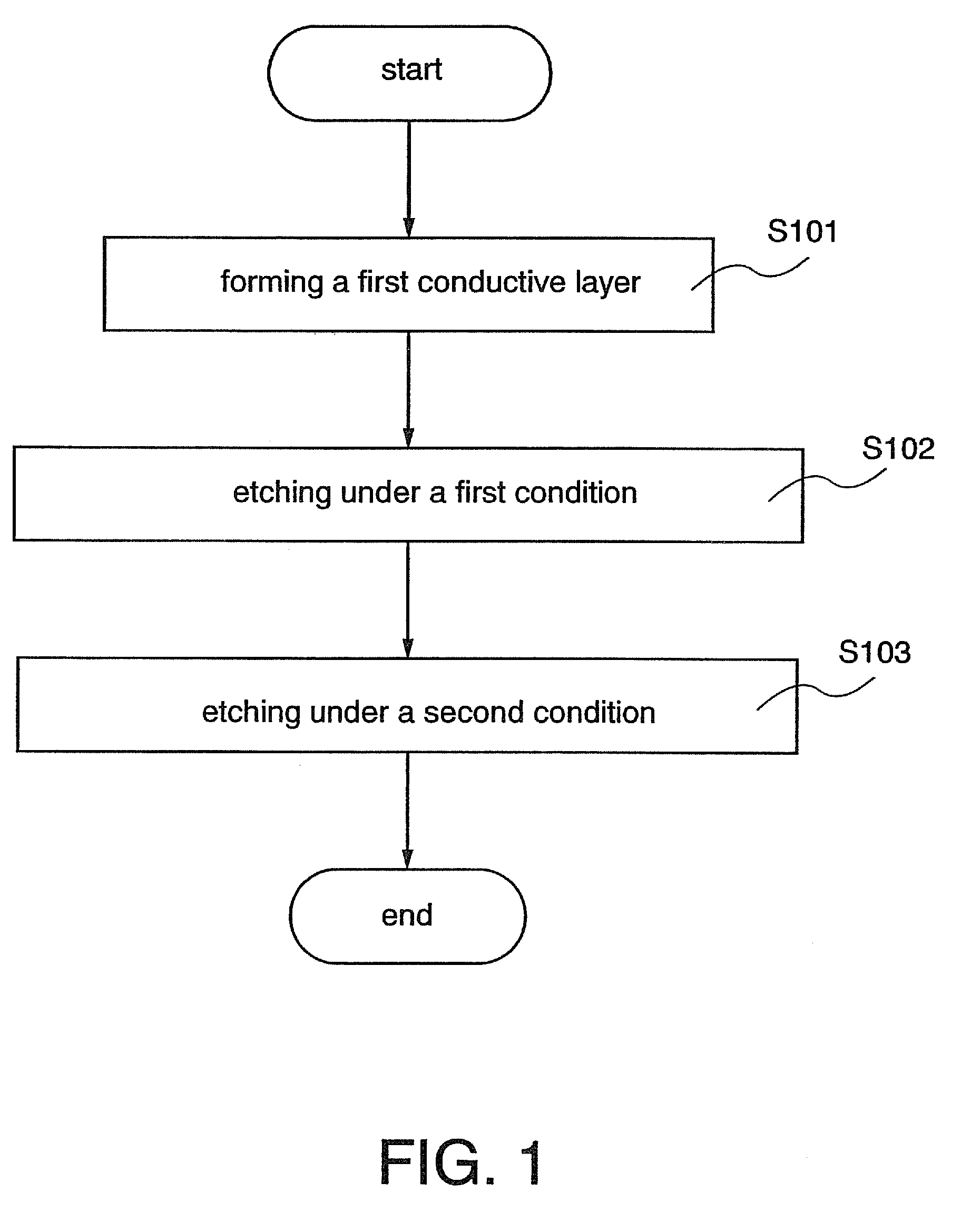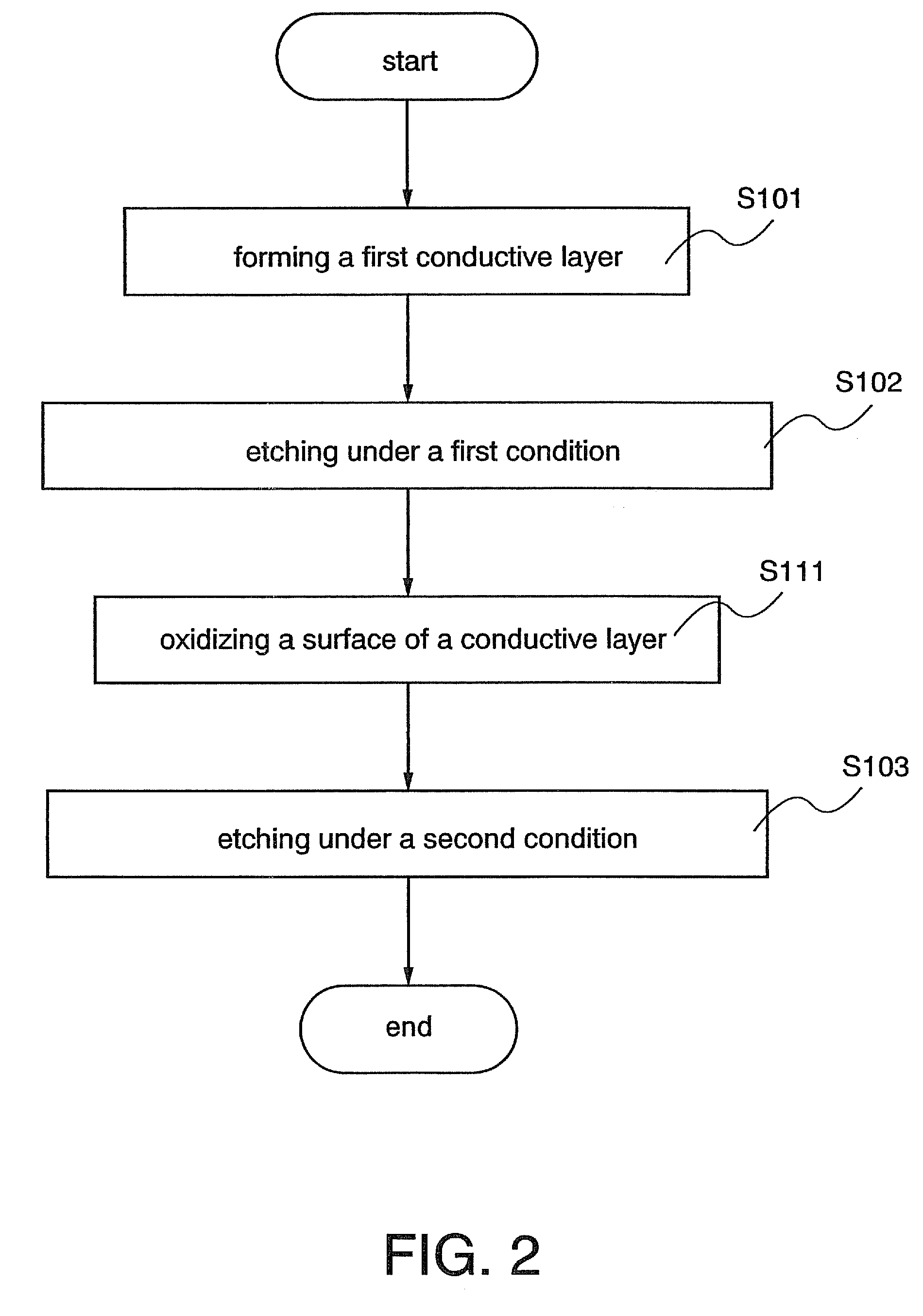Wiring over substrate, semiconductor device, and methods for manufacturing thereof
a semiconductor device and substrate technology, applied in non-linear optics, instruments, optics, etc., can solve the problems of deterioration of the insulating layer provided between the wiring, short circuit or short circuit of the wiring, and increase the projection and depression difference, so as to prevent short circuit between the wiring and the insulating layer from cracking, the effect of high yield
- Summary
- Abstract
- Description
- Claims
- Application Information
AI Technical Summary
Benefits of technology
Problems solved by technology
Method used
Image
Examples
embodiment 1
[0047]In this embodiment, a method for manufacturing a wiring over a substrate comprising a wiring having a side with a curved face by an etching process under a first condition and an etching process under a second condition is explained with reference to FIGS. 1, 3A to 3D, and 7.
[0048]As illustrated in FIG. 3A, a first insulating layer 101 is formed over a substrate 100, and a first conductive layer 102 is formed over the first insulating layer 101. Then, a first mask pattern 103 is formed over the first conductive layer 102 (a step S101 in FIG. 1).
[0049]As the substrate 100, a substrate made from an insulating material such as a glass substrate, a quartz substrate, or alumina substrate; a plastic substrate having heat resistance that can resist processing temperature in a later process; a silicon wafer; a metal plate; or the like can be used. In this instance, an insulating film for preventing dispersion of impurities from the substrate such as silicon oxide (SiOx), silicon nitri...
embodiment 2
[0067]In this embodiment, a method for manufacturing a wiring having a side with a curved face according to a different etching condition from that explained in Embodiment 1 is explained with reference to FIGS. 1, 4A to 4D, and 7.
[0068]As illustrated in FIG. 4A, as is the case with Embodiment 1, a first insulating layer 101 is formed over a substrate 100, and a first conductive layer 102 is formed over the first insulating layer 101. Then, a first mask pattern 103 is formed over the first conductive layer 102 (a step S101 in FIG. 1).
[0069]As illustrated in FIG. 4B, the first conductive layer 102 is etched by using the first mask pattern 103 under a first condition to form a second conductive layer 211 having a side perpendicular to the first mask pattern 103 (a step S102 in FIG. 1). The first condition is the condition by which the first conductive layer 102 is anisotropically etched, typically, a conductive layer having a perpendicular side is formed. Further typically, the first c...
embodiment 3
[0076]In this embodiment, a method for manufacturing a wiring having a side having a plurality of inclined planes according to a different etching process from that in Embodiments 1 and 2 is explained with reference to FIGS. 2, 5A to 5F, and 8.
[0077]As illustrated in FIG. 5A, a first insulating layer 101 is formed over a substrate 100 as is the case with Embodiment 1, and a first conductive layer 102 is formed over the first insulating layer 101. Then, a first mask pattern 103 is formed over the first conductive layer 102 (a step S101 in FIG. 2).
[0078]As illustrated in FIG. 5B, the first conductive layer 102 is etched by using the first mask pattern 103 under a first condition to form a second conductive layer 302 (a step S102 in FIG. 2). The first condition is the condition by which the first conductive layer 102 is etched, therefore, a conductive layer having a tapered edge is formed. In this instance, the first condition in this example is the same as that in Embodiment 1. Note t...
PUM
| Property | Measurement | Unit |
|---|---|---|
| angle | aaaaa | aaaaa |
| angle | aaaaa | aaaaa |
| angle | aaaaa | aaaaa |
Abstract
Description
Claims
Application Information
 Login to View More
Login to View More - R&D
- Intellectual Property
- Life Sciences
- Materials
- Tech Scout
- Unparalleled Data Quality
- Higher Quality Content
- 60% Fewer Hallucinations
Browse by: Latest US Patents, China's latest patents, Technical Efficacy Thesaurus, Application Domain, Technology Topic, Popular Technical Reports.
© 2025 PatSnap. All rights reserved.Legal|Privacy policy|Modern Slavery Act Transparency Statement|Sitemap|About US| Contact US: help@patsnap.com



